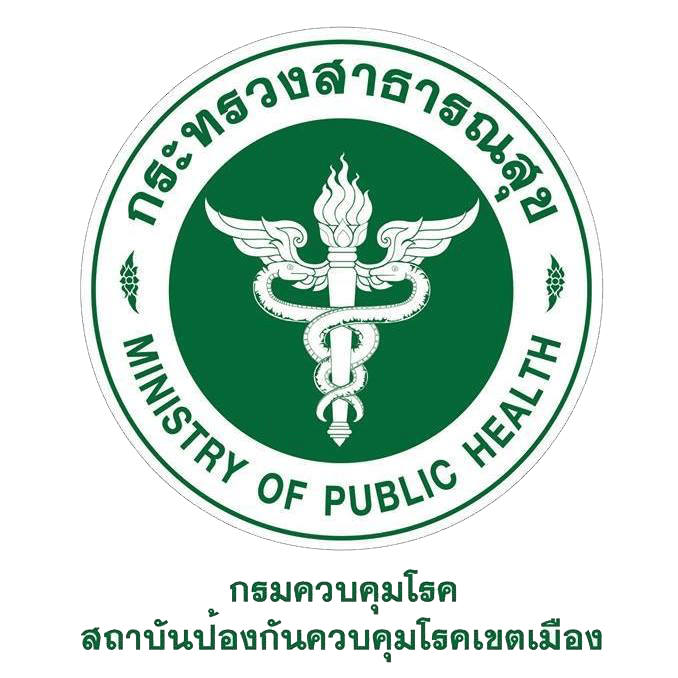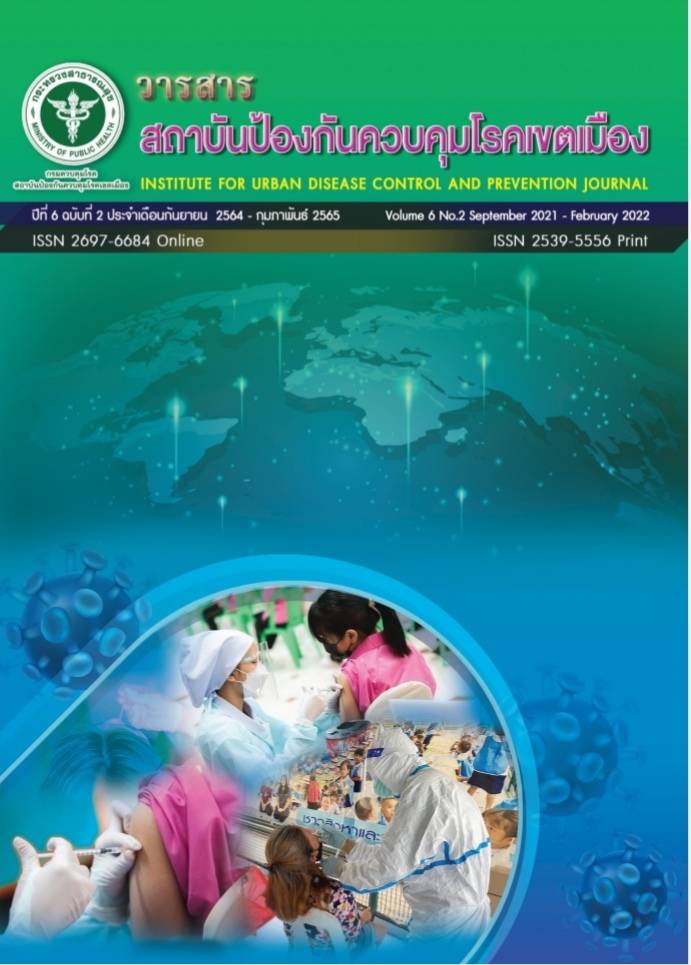การศึกษาอัตราการติดเชื้อวัณโรคระยะแฝง และการป่วยเป็นวัณโรคในบุคลากรทางการแพทย์ในโรงพยาบาลขนาดใหญ่
Main Article Content
บทคัดย่อ
บุคลากรทางการแพทย์เป็นกลุ่มเสี่ยงต่อการติดเชื้อวัณโรคระยะแฝง ปัจจุบันยังมีข้อจำกัดของข้อมูลด้านการค้นหาอัตราความชุกวัณโรคระยะแฝงซํ้าในปีที่ 2 การป่วยเป็นวัณโรค รวมไปถึงความสำเร็จในการกินยาเพื่อรักษาการติดเชื้อวัณโรคระยะแฝง โดยวัตถุประสงค์ เพื่อศึกษาอัตราการติดเชื้อวัณโรคระยะแฝงในปีที่ 2 อัตราการป่วยเป็นวัณโรค และอัตราสำเร็จในการรักษาผู้ติดเชื้อวัณโรคระยะแฝงด้วยสูตรยา 3HP
การศึกษาครั้งนี้เป็นการศึกษาเชิงพรรณนาแบบภาคตัดขวาง ระยะเวลาดำเนินการตั้งแต่เดือนตุลาคม พ.ศ. 2561 ถึงเดือนมีนาคม พ.ศ. 2563 โดยการตรวจด้วยเครื่อง IGRA QuantiFERON-TB Gold Plus (QF-Plus) ผลจากการศึกษาครั้งนี้ พบว่า การติดเชื้อวัณโรคระยะแฝงในปีที่ 2 พบจำนวน 35 ราย จากทั้งหมด 536 ราย ร้อยละ 6.5 ปัจจัยทางด้าน ขนาดเตียง (น้อยกว่าหรือเท่ากับ 500 เตียงและมากกว่า 500 เตียงขึ้นไป) มีความแตกต่างกันอย่างมีนัยสำคัญทางสถิติ (p<0.05) และเขตสุขภาพมีความสัมพันธ์กับอัตราการติดเชื้อวัณโรคระยะแฝงในปีที่ 2 อย่างมีนัยสำคัญทางสถิติ (p<0.05) ความสำเร็จของการกินยาจำนวน 24 ใน 29 ราย คิดเป็นร้อยละ 82.8 แต่มี 5 รายที่หยุดยาเนื่องจากผื่นผิวหนังมากที่สุด และการป่วยเป็นวัณโรค(active TB) ในบุคลากรทางการแพทย์ หลังจากพบว่า IGRA มีผลเป็นบวก จำนวน 4 ราย จากทั้งหมด 536 ราย คิดเป็นร้อยละ 0.7 วัณโรคเป็นปัญหาที่สำคัญของระบบสาธารณสุขของประเทศไทย บุคลากรทางการแพทย์ควรได้รับการตรวจและการได้รับยารักษาวัณโรคระยะแฝงทันที ติดตามการป่วยเป็นวัณโรครายปี เพื่อป้องกันการเกิดวัณโรค และสามารถยุติวัณโรคได้ในอนาคต
Article Details

อนุญาตภายใต้เงื่อนไข Creative Commons Attribution-NonCommercial-NoDerivatives 4.0 International License.
บทความที่พิมพ์ในวารสารสถาบันป้องกันควบคุมโรคเขตเมือง ถือว่าเป็นผลงานวิชาการ งานวิจัยและวิเคราะห์ ตลอดจนเป็นความเห็นส่วนตัวของผู้เขียนเอง ไม่ใช่ความเห็นของสถาบันป้องกันควบคุมโรคเขตเมือง หรือคณะบรรณาธิการแต่ประการใด ผู้เขียนจำต้องรับผิดชอบต่อบทความของตน
เอกสารอ้างอิง
WHO consolidated guidelines on Tuberculosis. Module 1: prevention – tuberculosis preventive treatment. Geneva: World Health Organization; 2020.
กองวัณโรค. แนวทางการควบคุมวัณโรคประเทศไทย พ.ศ. 2564. พิมพ์ครั้งที่ 1. กรุงเทพฯ: อักษรกราฟฟิคแอนด์ดีไซน์; 2564.
World Health Organization. Global tuberculosis report 2018. Geneva: WHO; 2018: 16-18.
Ditthawat Nonghanphithak,Wipa Reechaipichitkul, Tassamonwan Chaiyasung,Kiaticahi Faksri. Risk Factor for Latent Tuberculosis Infection Among Health-care Workers in Northeatern Thailand. Southeast Asian J Trop Med Public Health. 2016;47(6):1198–208.
บุญเชิด กลัดพ่วง, ชำนาญ ยุงไธสง, ผลิน กมลวัทน์. อัตราความชุกการติดเชื้อวัณโรคระยะแฝงในบุคลากรทางการแพทย์และสาธารณสุขในโรงพยาบาลขนาดใหญ่ จากการตรวจด้วยวิธี Interferon-Gamma Release Assay (IGRA). วารสารโรคเอดส์. 2021;33(1):21–35.
Arguello Perez E, Seo SK, Schneider WJ, Eisenstein C, Brown AE. Management of Latent Tuberculosis Infection Among Healthcare Workers: 10-Year Experience at a Single Center. Clin Infect Dis Off Publ Infect Dis Soc Am. 2017;65(12): 2105–11.
Zwerling A, Benedetti A, Cojocariu M, McIntosh F, Pietrangelo F, Behr MA, et al. Repeat IGRA Testing in Canadian Health Workers: Conversions or Unexplained Variability?. PLoS ONE. 2013;8(1):e54748.
Khawcharoenporn T, Aksornchindarat W, Yodpinij N, Srisungngam S, Rudeeaneksin J, Bunchoo S, et al. T-SPOT®.TB Test for Latent Tuberculosis Infection Diagnosis and Treatment Guidance in Thai Health-Care Professionals. Indian J Occup Environ Med. 2020;24(1):47–9.
Schablon A, Nienhaus A, Ringshausen FC, Preisser AM, Peters C. Occupational Screening for Tuberculosis and the Use of a Borderline Zone for Interpretation of the IGRA in German Healthcare Workers. Diel R, editor. PLoS ONE. 2014;9(12):e115322.
Lee K, Han MK, Choi HR, Choi C-M, Oh Y-M, Lee SD, et al. Annual Incidence of Latent Tuberculosis Infection among Newly Employed Nurses at a Tertiary Care University Hospital. Infect Control Hosp Epidemiol. 2009;30(12):1218–22.
Lee S, Lee W, Kang S-K. Tuberculosis infection status and risk factors among health workers: an updated systematic review. Ann Occup Environ Med. 2021;33:e17.
Zhang X, Jia H, Liu F, Pan L, Xing A, Gu S, et al. Prevalence and Risk Factors for Latent Tuberculosis Infection among Health Care Workers in China: A Cross-Sectional Study. PloS One. 2013;8(6):e66412.
Shahieda A, Rodney E, Roslynn B, Richard N. van Zyl-Smit, Qonita Said-Hartley, Rodney Da, et al. Incidence of occupational latent tuberculosis infection in South African healthcare workers. Eur Respi J. 2015; 45: 1364-73.
Njie GJ, Morris SB, Woodruff RY, Moro RN, Vernon AA, Borisov AS. Isoniazid-Rifapentine for Latent Tuberculosis Infection: A Systematic Review and Meta-analysis. Am J Prev Med. 2018;55(2):244–52.
Sun H-Y, Huang Y-W, Huang W-C, Chang L-Y, Chan P-C, Chuang Y-C, et al. Twelve-dose weekly rifapentine plus isoniazid for latent tuberculosis infection: A multicentre randomised controlled trial in Taiwan. Tuberc Edinb Scotl. 2018;111:121–6.
Pease C, Hutton B, Yazdi, F, Wolfe D, Hamel C, Barbeau P, Skidmore B, Alvarez G.G. A systematic review of adverse events of rifapentine and isoniazid compared to other treatments for latent tuberculosis infection. Pharmacoepidemiol Drug Saf. 2018; 27:557 - 56.
Shiferaw MB, Sinishaw MA, Amare D, Alem G, Asefa D, Klinkenberg E. Prevalence of active tuberculosis disease among healthcare workers and support staff in healthcare settings of the Amhara region, Ethiopia. PLOS ONE. 2021;16(6):e0253177.
Kehinde AO, Baba A, Bakare RA, Ige OM, Gbadeyanka CF, Adebiyi OE. Pulmonary tuberculosis among health care workers at two designated DOTS Centers in urban city of Ibadan, Nigeria. Indian J Med Res. 2011;133:613–7.


